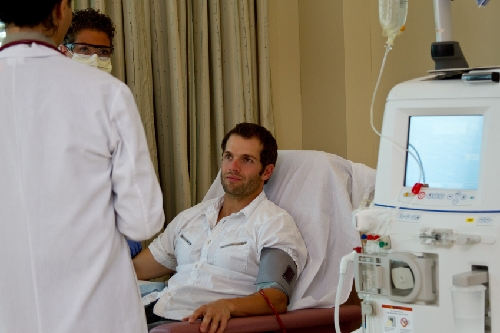 Among patients with chronic kidney disease (CKD), the risk of outright kidney failure is an ever-present threat. Now, a Winnipeg researcher has devised an equation that he believes can be a reliable predictor of kidney failure in any patient who has reached at least stage three CKD.
Among patients with chronic kidney disease (CKD), the risk of outright kidney failure is an ever-present threat. Now, a Winnipeg researcher has devised an equation that he believes can be a reliable predictor of kidney failure in any patient who has reached at least stage three CKD.
The equation itself only uses five metrics: a patient’s age, gender, geographic region (North American or non-North American), and two values derived from a urinalysis (albumin: creatinine ratio and glomerular filtration rate). The values are run through the equation and the result is the patient’s likelihood of developing kidney failure within the next two to five years.
The equation’s designer, Dr. Navdeep Tangri, originally published his finding back in 2011 but his study only included Canadian participants. Responding to critics who noted the lack of scope, Tangri began an extensive meta-analysis that covered 721,357 patients across 30 countries and four continents. Data was collected on patients dating as far back as 1982 and subsequently run through the equation before being compared to their outcomes to check for accuracy.
This new study found the equation to be accurate among 95% of cases at the two year mark and in 88% of cases at the five year mark. It initially over-estimated the risk of kidney failure in non-North American patients. Once a calibration factor was added, accuracy outside of North America improved significantly and became more consistent with the North American results. Interestingly, a patient’s environment and other health conditions (like diabetes) did not significantly alter the accuracy of the equation’s predictions.
Tangri and his collaborators also realized that no matter how simple the equation was, it wouldn’t catch on unless it was simple to employ. Consequently, numerous tools ranging from smartphone apps to an online calculator and website—appropriately titled kidneyfailurerisk.com—have been designed in order to reduce any barriers physicians might have towards making use of the equation.
It is hoped that the equation’s publication in the Journal of the American Medical Association will give the equation broader attention and see it put to more widespread use.
As we previously reported, research published in the Clinical Journal of the American Society of Nephrology shows how diabetics who increase their intake of potassium can decrease their risk of kidney disease—or at the very least at the very least, slow down its advancement.
Sources for Today’s Article:
Hoye, B., “Winnipeg Researcher Makes Predicting Kidney Failure Easy with Simple Equation,” CBC news web site, January 12, 2016; http://www.cbc.ca/news/canada/manitoba/winnipeg-researcher-makes-predicting-kidney-failure-easy-with-simple-equation-1.3399857.
Tangri, N. et al., “Multinational Assessment of Accuracy of Equations for Predicting Risk of Kidney Failure,” Jama 315, no. 2 (January 12, 2016): 164.
